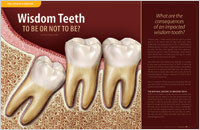
Wisdom Teeth
Wisdom teeth are a valuable asset to the mouth when they're healthy and properly positioned. But often problems develop that require their removal. When the jaw isn't large enough to accommodate wisdom teeth, they can become impacted Wisdom teeth may grow sideways, emerge only part way from the gum or remain trapped beneath the gum and bone.
Extraction of wisdom teeth is generally recommended when:
- Wisdom teeth only partially erupt. This leaves an opening for bacteria to enter around the tooth and cause an infection. Pain, swelling, jaw stiffness and general illness can result.
- There is a chance that poorly aligned wisdom teeth will damage adjacent teeth.
- A cyst (fluid-filled sac) forms, destroying surrounding structures such as bone or tooth roots.
You should ask me about the health and positioning of your wisdom teeth. I may make a recommendation for removal.
Impacted Teeth
Removal of Impacted Teeth: What You Need To Know
Impacted teeth are simply teeth that haven't grown into a healthy position because they've run into something such as another tooth, bone or gum. Most impacted teeth need to be removed because sooner or later they cause major problems such as serious infection, pain, swelling, sinus problems, ear problems, cysts or they can even damage other healthy teeth.
Although impacted teeth aren't painful at the beginning, sooner or later they cause a great deal of pain, usually at the most inconvenient time. This is one of many reasons why even though your impacted teeth may have never bothered you, it's a good idea to have them removed before they do.
Pathology arising from impacted teeth includes recurring infections which ranges in severity from minor to life-threatening; resorption of adjacent teeth, periodontal problems, decay of neighbouring teeth, weakening of the jaw bone, and development of numerous cysts and tumours. These pathological conditions develop with increasing frequency after 30 years of age.
The National Institutes of Health, the Canadian and American Associations of Oral and Maxillofacial Surgeons all agree that impacted teeth are pathological entities and surgical removal is the best treatment.
The usual result of treatment of impacted teeth is uncomplicated healing with no significant, lasting problems. This is my experience in almost all of my patients. Postoperative complications occur in any surgical procedures, and in this surgical procedure the complication rate is low, but increases with age. The most common complications are delayed healing and infection.
The Earlier, The Better
Generally, the younger you are, the easier it is to remove impacted teeth and recover from it. Almost everyone under the age of 20 years does very well with a low incidence of complications such as delayed healing.
Between 21 to 25 years about 30% of patients experience difficulties. About 60% of people aged 26 to 30 have a complication, usually minor, after surgery and about 90% of those over 30 years of age will have problems after their surgery but with proper measures these can be minimized.
Most common complications are things such as bruising, swelling, aching, slow healing or prolonged bleeding. Other rare complications include infection, cracking and chipping of the bone near the tooth socket, leaving a piece of the tooth in the socket, or very rarely, numbness from the nerve near lower teeth and problems with the sinus near upper teeth.
Avoiding Bruising, Swelling & Discomfort
Patients are usually most concerned about bruising, swelling and pain after surgery. Knowing this I make the following suggestions to help you. These recommendations are based on well-proven, conservative scientific evidence:
- Apply ice packs to the corner of the jaws, just under your ears after your surgery for approximately 48 hours. Icing thoroughly for an extended time is the single most important and effective thing you can do. It's important that the cold compresses conforms to your face closely and that you ice long enough to make the area actually cold to the touch.
- Don't cover the ice pack with a thick layer of cloth or paper. Ideally, the ice should be placed directly on your skin or covered by a thin layer of plastic.
- Use a bag of frozen peas and a bag of frozen corn if you have had surgery done on both sides. Place the bag of frozen peas on the right side for about 20 minutes and then put it back in the freezer. Get the bag of frozen corn and place it on the left side for 20 minutes and then go back and use the peas on the right side while the corn re-freezes. Continue icing each side alternately for the rest of the day of your surgery as well as the next two days.
|
|
| Featured Article on Wisdom Teeth – View all | |

|
Wisdom Teeth – To Be Or Not To Be |
At Dentistry Asleep®,Dr. Kevin Dann offers dental hygiene services, routine dental care for adults and children, periodontal and endodontic therapy, cosmetic dental procedures and dental implants. Dr. Dann is one of the few Certified Specialists in Dental Anaesthesia, giving complete, comfortable care to all his valued patients. Enjoy experienced, anxiety-free dental healthcare! Make your appointment now!
